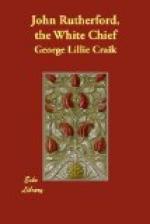[Footnote CA: Another rendition of Hokianga.]
[Footnote CB: Mr. Craik adds a note stating that the place which Rutherford here calls Wangalore is Wangaroa. (The proper spelling is Whangaroa.) The ship, he says, was the “Mercury,” of London, South Sea whaler, which put in at Wangaroa on March 5th, 1825, and was plundered of the greater part of her cargo by the natives. She was also so much disabled by the attack made upon her that, after a vain attempt to carry her round to the Bay of Islands, it was found necessary to abandon her, when she drove to sea, and asserted that no cause of offence whatever was given to the natives by the captain or crew of the “Mercury,” while the conduct of the former was in all respects treacherous, unfeeling, and provoking.]
[Footnote CC: All the names are spelt wrongly.]
[Footnote CD: Probably Matui or Matohi.]
[Footnote CE: Evidently Hauraki, which, however, is on the east coast, while Knipara is on the west.]
CHAPTER XII.
This is, we believe, the most complete account, and, at the same time, the one most to be depended on, which has yet been given to the public, of a New Zealand battle. None of the other persons who have described to us the manners of these savages have seen them engaged with each other, except in a sham fight; although Nicholas, on one occasion, was very near being afforded an opportunity of witnessing a real combat. That gentleman and Marsden, however, have given us some very interesting details respecting the preliminaries to an actual engagement. They describe the debates which generally take place in the war-council of a tribe or district previous to any declaration of hostilities; and those conferences between the two opposing parties in which, even after they have met on the intended field of action, the matter of dispute is often made the subject of a war of argument and eloquence, and sometimes, it would seem, is even settled without any resort to more destructive weapons.
When Marsden visited the neighbourhood of the Shukehanga, in 1819, he found a quarrel just about to commence between two of the principal chiefs, whose lands lay contiguous, and who were also, it appeared, nearly related, in consequence of the pigs of the one having got into the sweet potato grounds of the other, who had retaliated by shooting several of them. The chief whose pigs had committed the trespass, and whom Marsden was now visiting, was an old man, apparently eighty years of age, named Warremaddoo,[CF] who had now resigned the supreme authority to his son Matanghee;[CG] yet this affair rekindled all the ancient enthusiasm of the venerable warrior. The other chief was called Moodewhy.[CH] The morning debate, at which several chiefs spoke with great force and dignity, had been suddenly interrupted; but it was resumed in the evening, when Marsden was again present.




